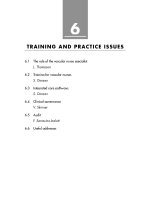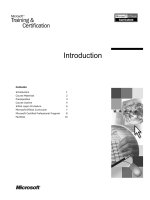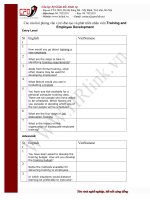TRAINING AND DEVELOPING,Unit II assessment
Bạn đang xem bản rút gọn của tài liệu. Xem và tải ngay bản đầy đủ của tài liệu tại đây (91.23 KB, 6 trang )
Take Test: Unit II Assessment
Question 1
In motivating trainees to learn, which of the following needs - existence,
relatedness, or growth - should be the focus?
Existence
s
Relatedness
Growth
Both B & C
All of the above(p.64)ok
4 points
Question 2
The _____ the self efficacy, the _____ the performance.
higher; worse
higher; better( P.72)dung
lower; worse
lower; better
all of the above are possible
4 points
Question 3
Which of these statements is inaccurate?
Maslow is known for his early work on needs and motivation( P.64)
Alderfrer developed a needs theory based on Maslow's early work
Existence needs are the highest order needs(p.64)dung
Relatedness reflects people's need to be valued by others
1
Recognition can fulfill growth needs.
Question 4
Which of the following statements best explains the relationship between
training and self efficacy?
The two concepts are not related.
Training can act to improve low self efficacy only when employees have the
required KSA's.
It is useful to assess trainee self efficacy prior to training only.
Self efficacy beliefs are a good predictor of learning in the training environment.
( P.73)ok
4 points
Question 5
The Gagne-Briggs theory of instructional design argues that
The learning process cannot be influenced by the trainer
The external events influence the internal learning process(P.78)ok
Presenting the material should be the first step in training program
The order of events does not alter the results
4 points
Question 6
Theories are
useful for model building but impractical for practitioners.
generally developed by all of us to help us understand how things work in our
world.
concrete steps in the "how to" world.
useful when they describe a set of facts and develop a logical rationale for what is
likely to be true, given those facts.
both B & D( P.61)ok
4 points
2
Question 7
In social learning, theory retention(giulai)has three phases which are
attention, symbolic coding, behavioral reproduction.
recognize, recall, retain.
attention, motivation, symbolic coding.
None of the above.(P.76)ok
4 points
Question 8
Understanding needs theory is important in the training process because:
Needs theory helps identify reasons why some people do not perform well(P.64)
Needs theory can help determine what kind of training will be more effective
Needs theory can inform the choice of environment where training is held
Needs theory can help identify motivators that will improve performance
All of the above
4 points
Question 9
Negative reinforcement
reduces the likelihood of a behavior.
increases the likelihood of a behavior.
requires removal of something unpleasant.
both A & C.
both B & C.(P.68)dung
4 points
Question 10
3
The formula for performance (M X KSA X E) suggests
only two of the three factors need to be favorable to obtain high performance.
if motivation is high and KSA's are adequate, at least moderate performance will be
achieved.
if the environment is highly conducive to high performance, then motivation is not
very important.
none of the above are correct.ok
4 points
Question 11 30 points
Explain Social Learning Theory
According to Albert Bandura and his associates (2000), the theory is about a model of
learning known variously as observational learning, vicarious learning, and most often, social
learning theory. Social learning theory is the view that people learn by observing others or social
learning theory explains how people learn new behaviors, values, and attitudes. Albert Bandura
and his associates (2000) indicates that the cognitive processes that are a part of social learning
theory are motivation, attention, retention, and to some extent behavioral reproduction.
Motivation influences and is influenced by the other processes. The learner’s needs
determine what things receive attention and are processed for retention. (Blanchard, & Thacker,
2000). Bandura (1977) states that in order to learn, learners need to be paying attention. Anything
that detracts their attention is going to have a negative effect on observational learning. If the
model interesting or there is a novel aspect to the situation, they are far more likely to dedicate
your full attention to learning. Once attention is focused on an object or event, the ability to store
information is also an important part of the learning process. Retention can be affected by a
number of factors, but the ability to pull up information later and act on it is vital to
observational learning. Behavioral reproduction is repeated practice. (Blanchard, & Thacker,
2000). Once learners have paid attention to the model and retained the information, it is time to
4
actually perform the behavior you observed. Further practice of the learned behavior leads to
improvement and skill advancement.
In short, Social Learning Theory states behavior which is learned from the environment
through the process of observational learning.
References
Blanchard, N.P., & Thacker, J. (2010). Effective training, systems, strategies and practices
(Custom 4th ed.). Upper Saddle River, NJ: Prentice Hall.
Bandura, A. (1977). Social Learning Theory. Englewood Cliffs, NJ: Prentice Hall.
hb
Question 12 30 points
Two definitions of learning were presented in the text, one was behavioral and
one was cognitive. Explain each and indicate the major difference between
these definitions and what the training implications of each are.
Blanchard & Thacker (2000) show that there are two categories of learning theory which
are behavioral and cognitive. Behavioral learning is measured in terms of relatively permanent
changes in behavior. This becomes the operational definition of learning for theorists. Cognitive
5
theory is referring to mental activities such as seeing, feeling, attending, remembering and
solving problems.
The differences in the definition of learning might not seem important. It might seem to
be a simple difference of whether learning is synonymous with behavior or of how information is
processed, organized, and stored. (Blanchard & Thacker ,2000) The behaviorist approach
indicates that the environment controls learning. According to B.F. Skinner’s explanation,
learning is defined by changing of relatively permanent in behavior. Behaviorists specially adopt
the definition of learning. Nevertheless, Blanchard & Thacker (2000) express that the cognitive
approach shows that the learner controls learning. Prospective learners come to training with
their own set of goals and priorities. For cognitive theorists, the learner controls both what is
learned and how it is learned.
In short, it is believed that integrating the substantiated aspects of both approaches
explain learning in full. Depending on some learning situations, a cognitive method can be
worked better and for others a behaviorist method can work more efficiently. (Blanchard &
Thacker ,2000)
.
Reference :
6
Blanchard, N.P., & Thacker, J. (2010). Effective training, systems, strategies and practices
(Custom 4th ed.). Upper Saddle River, NJ: Prentice Hall.
7









